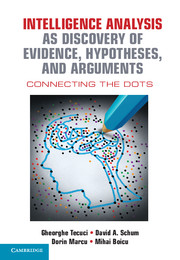Book contents
- Frontmatter
- Contents
- Preface
- Acknowledgments
- About the Authors
- 1 Intelligence Analysis: “Connecting the Dots”
- 2 Marshaling Thoughts and Evidence for Imaginative Analysis
- 3 Disciple-CD: A Cognitive Assistant for Connecting the Dots
- 4 Evidence
- 5 Divide and Conquer: A Necessary Approach to Complex Analysis
- 6 Assessing the Believability of Evidence
- 7 Chains of Custody
- 8 Recurrent Substance-Blind Combinations of Evidence
- 9 Major Sources of Uncertainty in Masses of Evidence
- 10 Assessing and Reporting Uncertainty: Some Alternative Methods
- 11 Analytic Bias
- 12 Learning and Reusing Analytic Expertise: Beyond Disciple-CD
- Glossary of Terms
- References
- Appendixes
- Index
Appendixes
Published online by Cambridge University Press: 05 August 2016
- Frontmatter
- Contents
- Preface
- Acknowledgments
- About the Authors
- 1 Intelligence Analysis: “Connecting the Dots”
- 2 Marshaling Thoughts and Evidence for Imaginative Analysis
- 3 Disciple-CD: A Cognitive Assistant for Connecting the Dots
- 4 Evidence
- 5 Divide and Conquer: A Necessary Approach to Complex Analysis
- 6 Assessing the Believability of Evidence
- 7 Chains of Custody
- 8 Recurrent Substance-Blind Combinations of Evidence
- 9 Major Sources of Uncertainty in Masses of Evidence
- 10 Assessing and Reporting Uncertainty: Some Alternative Methods
- 11 Analytic Bias
- 12 Learning and Reusing Analytic Expertise: Beyond Disciple-CD
- Glossary of Terms
- References
- Appendixes
- Index
Summary
METHODOLOGICAL GUIDELINES
Guideline 3.1: Work with only one knowledge base loaded in memory (p. 52)
Guideline 3.2: Create a knowledge base and save successive versions (p. 52)
Guideline 5.1: Define analysis trees in natural language using simple questions (p. 114)
Guideline 5.2: Identify the specific instances, the generic instances, and the constants (p. 114)
Guideline 5.3: Learn and reuse reduction patterns (p. 115)
Guideline 5.4: Define short hypotheses names for the abstract reasoning tree (p. 115)
HANDS-ON EXERCISES
3.2 Obtaining Disciple-CD (p. 48)
3.3 Hands On: Working with Knowledge Bases (p. 49)
3.5 Hands On: Browsing an Argumentation (p. 53)
Knowledge Base: 01-Browse-Argumentation
4.4.1 Hands On: Define and Evaluate Evidence (p. 73)
Knowledge Base: 02-Evaluate-Evidence
4.5.1 Hands On: From Information to Evidence (p. 79)
Knowledge Base: 03-Info-to-Evidence
5.7.1 Hands On: Was the Cesium Canister Stolen? (p. 93)
Knowledge Base: 04-Evidence-based-Analysis
5.7.2 Hands On: Development and Evaluation of an Argument (p. 98)
Knowledge Base: 05-Modeling-Lerning
5.7.3 Hands On: Analysis Based on Previously Learned Patterns and Synthesis Functions (p. 101)
Knowledge Base: 06-Analysis-Reuse
5.8.1 Hands On: Abstraction of Analysis (p. 102)
Knowledge Base: 07-Abstraction
5.8.2 Hands On: Hypothesis Analysis and Evidence Search (p. 104)
Knowledge Base: 08-Evidence-Search
5.8.3 Hands On: Justifications of Assumptions (p. 108)
Knowledge Base: 09-Assumption-Justification
5.8.4 Hands On: Top-down and Bottom-up Argument Development (p. 109)
Knowledge Base: 10-Argument-Development
6.9.1 Hands On: Believability Analysis (p. 133)
Knowledge Base: 11-Believability-Analysis
8.5.1 Hands On: Who Has Stolen the Cesium Canister? (p. 154)
Knowledge Base: 12-Who-Stole-Cesium
9.6.1 Hands On: Does a Terrorist Organization Have the Cesium Canister? (p. 167)
Knowledge Base: 13-Terrorist-Organization
10.10.1 Hands On: Will a Bomb Be Set Off in Washington, D.C.? (p. 208)
Knowledge Base: 14-Bomb-Set-Off
OPERATIONS WITH DISCIPLE-CD
Operation 3.1: Load and select a knowledge base (p. 50)
Operation 3.2: Save all the knowledge bases (p. 51)
Operation 3.3: Close a knowledge base (p. 52)
Operation 3.4: Create a user knowledge base (p. 52)
Operation 3.5: Run a case study (p. 58)
Operation 3.6: Browse the analysis of a hypothesis (p. 58)
Operation 3.7: Save and close a case study (p. 58)
Operation 4.1: Define an item of evidence (p. 76)
Operation 4.2: Associate evidence to hypotheses (p. 79)
Operation 4.3: Assess evidence (p. 79)
- Type
- Chapter
- Information
- Intelligence Analysis as Discovery of Evidence, Hypotheses, and ArgumentsConnecting the Dots, pp. 255 - 256Publisher: Cambridge University PressPrint publication year: 2016

